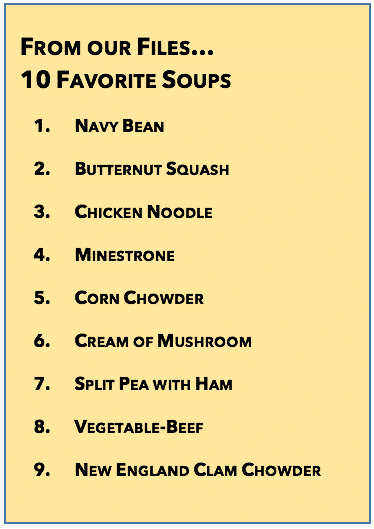One of the greatest pleasures of being in the food business is knowing that what we provide often ends up being the best part of another person’s day. This is even more true in our chosen niche, senior-living. Certainly, the nursing staff, housekeeping, event staff, groundskeepers, clinicians and others all fill very important, appreciated roles. But let’s face it: when we do a good job, our residents really look forward to their meals in a unique way.
A simple tactic that gives our residents reason to eagerly anticipate mealtime is serving them real comfort food. And, when it’s done right, nothing says comfort food like a nice bowl of soup. While many high-quality prepared soups are available, genuine made-from-scratch soup will always be more appreciated, more economical and better remind our diners of the kinds of soup they used to make for themselves and have enjoyed all their lives.
Rather than focus on specific recipes, let’s take a broad overview of soups in general. First, we’ll look at some traditional categories that many soups fall into. Then, we’ll learn the basic techniques of those categories. Using that foundation, you’ll be able to create different soups based on the other items on your menu, the seasons, culinary inspiration and ingredients you might find yourself needing to use up.
 Broths
Broths
Broths, or clear soups, make up our first category. These soups consist of a clear, flavorful broth garnished with various vegetables, meats, seafood and starches, depending on what kind of soup it is. Chicken-noodle and Chinese won-ton soups are good examples. Canned broths or a good-quality soup base can be used but, if ever there’s a time to make stock from scratch, this is it. If making your own stock isn’t practical for you, don’t let it stop you from making these soups; you’ll still end up with a great product your residents will love.
To make a “soup-worthy” broth, consider the three factors which comprise good stock-making technique: ingredients that fit the soup’s flavor profile, a good ratio of solids to liquid, and correct simmering time.
The appropriate ingredients come in two categories: animal and vegetable. In the animal category, lean, oven-browned protein or bones (especially chicken backs) are almost always a good call. Overly fishy seafood isn’t. For the vegetables, use various aromatic vegetables, considering the desired flavor of the final soup. For minestrone use roasted garlic and tomatoes. For Asian-style soups use stir-fried ginger, garlic and scallions. And for just about anything, use roasted or sweated onions, carrots and celery. Experiment to see what you like best, and remember that this is a great opportunity to use up products that might otherwise go to waste.
A good ratio to use is 8-10 pounds of solids to 5-6 quarts of liquid, which will yield about one gallon of broth. Simmer beef, veal or chicken bones for about 3 hours, and seafood for about 30 minutes. Always start with cold liquid, never let it get above a slow simmer, skim often, don’t add salt till you’re finishing the final soup, strain twice (coarse and fine), chill rapidly to <40°F and store refrigerated at <40°F in covered, labeled and dated containers till needed.
Once you have your broth, you just need to add the appropriate garnish. Draw on tradition, but don’t be afraid to use your imagination. And remember, this is the perfect place to use up even little bits of product you have on hand that you can’t figure out what else to do with. All garnishes should either fit into the spoon the guest will be using, or be easy to cut through with the side of the spoon, like a dumpling. For a Chinese-style shrimp & dumpling soup, add shrimp, soy sauce, small dumplings, finely sliced scallions and shitake mushrooms to a ginger-garlic-lemon grass-chicken broth. For minestrone, add diced cooked chicken, onions, diced tomatoes, tubetti pasta, cooked white beans and spinach to a roasted garlic-tomato-chicken broth. A great soup for the winter is a browned aromatic vegetable-beef bone broth garnished with beef, cooked barley and carrots. Let your residents’ preferences, the season, your imagination and product on hand guide your decisions.
Cream Soups
Traditional cream soups are rich, luxurious crowd pleasers. They’re made by simmering the soup’s main flavoring ingredient in either béchamel sauce (milk flavored with onion and thickened with roux) or velouté sauce (stock thickened with roux) until tender. The flavoring ingredients are then strained out, puréed in a blender and stirred back in. Just before service, the soup is finished with a liaison of egg yolks and heavy cream.
For the liaison, beat the yolks in a bowl. Separately, heat the cream to a simmer. Slowly beat the hot cream into the yolks, then stir the hot cream/yolk mixture into the simmering soup. For each gallon of béchamel or velouté, use about 3 pounds of the basic flavoring and a liaison of one pint of heavy cream and 4 yolks. (This will produce about 1½ gallons of soup.) The finished soup should have the consistency of heavy cream.
Besides being a real treat, these soups are also perfect for residents using fortified foods to supplement their calorie intake. Cream of asparagus is typical of these soups, garnished at service with blanched asparagus tips. Cream of chicken, or curried-chicken, garnished with shredded poached chicken breast is elegant and not very expensive to produce. Made-from-scratch cream of mushroom, cream of tomato and cream of broccoli-cheese (add shredded sharp cheddar at the last minute) can be real eye-openers for those who’ve only had canned versions.
Purée Soups
Purée soups are more rustic than cream soups. You begin by sweating aromatic vegetables like onions, celery, carrots and garlic in a little oil. Then add the main ingredients (dried beans, lentils, potatoes, leeks…), cover with stock or water, and simmer until tender. You can then either partially or totally purée the soup using an immersion blender or, in small batches, in a regular blender. (It’s safer to let the soup cool down before using a regular blender.) When puréed totally, and adding a little cream, you get a reasonable facsimile of a cream soup with less effort. Potato-leek, watercress, Tuscan white bean and split pea soups are classic puréed soups.
Chowders
Chowders are hearty, thick, milk-based soups containing potatoes (the exception being Manhattan clam chowder, a tomato-based affair.) The most well-known is New England clam chowder. To make the genuine article, render diced salt pork, sweat chopped onions and celery and add flour to make a white roux. Add the juice from canned clams, milk, bay leaves, fresh thyme and diced potatoes. (Extra credit is given for using actual, fresh clams.) Cook slowly till the potatoes are done, add chopped clams and serve. Corn chowder is also popular. Make it just like New England clam chowder, but leave out the clams and add corn kernels, preferably cut off the cob. The de-kernelled cobs, lightly roasted, can be cooked in the soup to add flavor, and then removed.
Soup is probably the first thing your guests will see and taste. Why not start the meal off with a bang? If it’s something special, it will set the tone for everything that follows.
